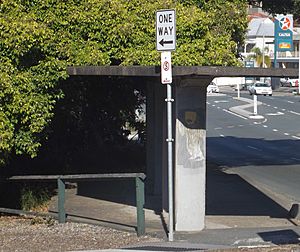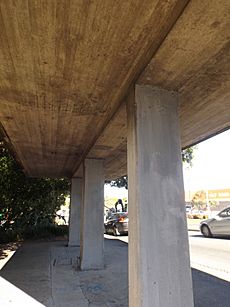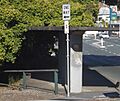Windsor Air Raid Shelter facts for kids
Quick facts for kids Windsor Air Raid Shelter |
|
|---|---|

The shelter is directly adjacent to busy Lutwyche Road, 2015
|
|
| Location | Lutwyche Road, Lutwyche, City of Brisbane, Queensland, Australia |
| Design period | 1939 - 1945 (World War II) |
| Built | c. 1942 |
| Architect | Frank Gibson Costello |
| Official name: Windsor Air Raid Shelter | |
| Type | state heritage (built) |
| Designated | 6 April 2005 |
| Reference no. | 602486 |
| Significant period | 1942 (fabric) 1940s (historical) |
| Builders | Brisbane City Council |
| Lua error in Module:Location_map at line 420: attempt to index field 'wikibase' (a nil value). | |
The Windsor Air Raid Shelter is a special building in Lutwyche, Australia. It was built during World War II to protect people from air raids. The Brisbane City Council constructed this concrete shelter around 1942. It was designed by a famous architect named Frank Gibson Costello. Today, it is listed on the Queensland Heritage Register because it is an important part of history.
Contents
Protecting People During World War II
Why Air Raid Shelters Were Needed
World War II began in 1939. On December 7, 1941, the United States joined the war after Japan bombed their fleet at Pearl Harbor in Hawaii. This made the war truly global. Soon after, Japan bombed Darwin, Australia, in February 1942. Many Australians were captured when Singapore fell. Australia quickly prepared for a possible Japanese invasion. Queensland became a key support base for the war in the Pacific. Many Australian and American soldiers came to Queensland. They needed new buildings and facilities quickly.
Brisbane's Role in the War
Brisbane became a very important city during the war. It was the biggest city in Queensland and the most northern major city in Australia. Military leaders set up their headquarters there. General Douglas MacArthur, the leader of the Allied Forces, worked from a building in Brisbane. General Sir Thomas Blamey, the leader of the Australian Forces, used the University of Queensland buildings. Because Brisbane was so important, it was a likely target for bombing. People needed protection fast.
Building Shelters and Defenses
The Brisbane City Council was in charge of protecting people from air raids. This included setting up air raid wardens and firefighting systems. They also built many air raid shelters. On Christmas Eve, 1941, the government told everyone to start building shelters. People dug trenches in parks and schoolyards. They taped windows to stop glass from shattering. They also had "brownouts," which meant dimming lights at night to make cities harder to see from the air.
The Brisbane City Council was ordered to build 200 public shelters. They started building on December 15, 1941. Later, they were asked to build 75 more. In the end, they built 235 air raid shelters. Most were finished by June 1942. They also dug about three kilometers of covered trenches in public parks. These trenches could hold many people. The Council also built shelters at wharves and other important places.
Clever Design for the Future
Frank Costello's Vision
Most structures built for the war were taken down after it ended. But some air raid shelters were designed to be used for other purposes. F.G. Costello, the Brisbane City Architect from 1941 to 1952, designed these special shelters. He wanted them to have a purpose even after the war. He said that if the shelters weren't needed for air raids, they could be changed into useful public buildings.
Costello's designs were modern for his time. He used new materials and focused on how buildings would be used. His designs often featured straight lines and flat roofs. Even though the shelters were small, they showed his modern style. Many of these reusable shelters were placed under fig trees to help hide them from enemy planes.
Different Types of Reusable Shelters
Costello designed a few types of reusable shelters.
- "Park" Type Shelters: These shelters had a roof supported by four central concrete pillars. This design allowed the outer walls to be removed after the war. Then, the shelter could become an open structure, like a shade shelter in a park. Many of these were made of brick or concrete.
- "Bus" Type Shelters: These shelters had a single-sided roof. They were designed so that three of their brick walls could be removed. This would leave a concrete back wall and several pillars at the front. They were meant to become bus stops or waiting shelters.
- "Bus (Stone)" Type Shelters: Similar to the "bus" type, but these had a stone back wall and stone pillars. Only a few of these were built.
Of the 235 public shelters built in Brisbane, 21 still exist today. Most of these surviving shelters were designed by Costello to be reused. The Windsor Air Raid Shelter is one of these "park" type shelters. Its outer walls were removed after the war, just as planned. You can still see where the walls used to be.
What the Windsor Shelter Looks Like Today
The Windsor air raid shelter is a rectangular concrete building. It has a strong floor and a flat roof. The roof is held up by concrete pillars. The shelter is unpainted. Part of the floor and roof have been cut off at one corner because the road gets narrower there. You can still see an old electricity box and wires inside. There is also evidence of where two small toilet partitions used to be. A mature fig tree stands close by, just as many shelters were originally placed.
Why This Shelter is Important
A Piece of History
The Windsor Air Raid Shelter shows us what life was like in Brisbane during World War II. It reminds us how people prepared for possible air attacks. It shows how the war affected everyday people in Brisbane.
A Rare Survivor
Many air raid shelters were built during the war, but only a few are still standing today. This shelter is one of the rare examples of buildings constructed by the Brisbane City Council specifically for wartime use that still exists.
Showing Key Features
The shelter's strong build, rectangular shape, and location near a busy area show what a typical public air raid shelter in Brisbane looked like during World War II.
Smart Design
The Windsor air raid shelter is now used as a simple shelter on a road. This shows how clever the original design was. It was built to be useful even after the war. It's a great example of smart design and how concrete was used during World War II.
Connected to a Famous Architect
This air raid shelter is also important because it shows the work of F.G. Costello. He was the City Architect and played a big role in designing these wartime structures.
Images for kids




